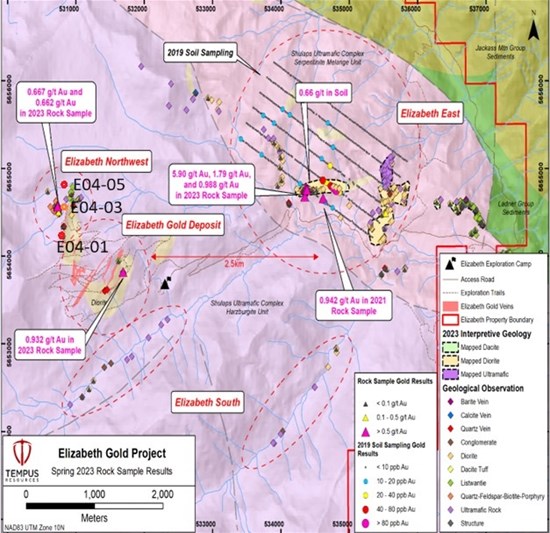
Perth, Australia--(Newsfile Corp. - September 21, 2023) - Tempus Resources Ltd. (ASX: TMR) (TSXV: TMRR) (OTC Pink: TMRFF) ("Tempus" or "the Company") is pleased to announce the assay results from the rock sampling program completed at Elizabeth in July. The Company also provides an update on the progress of work on its updated NI43-101/JORC resource estimate for the Elizabeth Project in British Columbia.
HIGHLIGHTS
- Assays received from the Elizabeth Gold Project rock sampling program completed in July, highlight the potential for two new areas that are prospective to host gold vein mineralisation:
Elizabeth East
- Located approximately 2.5km east of the current Elizabeth drilling area
- Rock chip samples with assay grades of up to 5.9g/t gold
Elizabeth Northwest
- Located approximately 1.0km north of the current Elizabeth drilling area
- Identified as northern extension of Listwanite Vein
- Two samples returned anomalous gold grades
- Elizabeth East and Elizabeth Northwest zones will be included in future drill programs targeting expansion of the overall gold mineralisation footprint at Elizabeth
Tempus Resources, President and CEO, Jason Bahnsen, commented "The results of the rock sampling program provide further evidence of the potential to significantly increase the mineralisation footprint at Elizabeth. Work continues on the updated resource estimate for Elizabeth with results expected to be received in October."
Elizabeth Rock Sampling Program
The Elizabeth Gold Project has an overall area of approximately 11,500 hectares. The recent drilling program at Elizabeth has focused on a small area of intrusive hosted quartz veins with an area of approximately 110 hectares.
The 2023 rock sampling and geological mapping program at Elizabeth focused on "ground truthing" the identified geophysical anomalies across three key target areas. Of the 90 rock ship samples collected, six showed anomalous gold assay grades (see Figure 1).

Figure 1 - Elizabeth Rock Sample Results
To view an enhanced version of this graphic, please visit:
https://images.newsfilecorp.com/files/7585/181370_d52be9c7642e2a06_001full.jpg
The sampling and mapping features of each of the key target areas are outlined below.
Elizabeth Northwest Zone
Fourteen rock samples were taken from an area to the northwest of the Elizabeth Main zone. The samples were collected within a protruding erosion-resistant outcrop which is the upper projection of Listwanite vein. Observed within the outcrop are multiple and intense anastomosing quartz, calcite and barite veining, within reddish, silicified listwanitic ultramafic where fuchsite was noted. Vuggy quartz was also noted.
Two rock samples returned anomalous gold assay results (see Appendix Table 1 for full details).
| | Elizabeth Northwest Rock Sample | | 0.662 grams per tonne gold |
| | Elizabeth Northwest Rock Sample | | 0.667 grams per tonne gold |
Three historical drill holes (E04-01, E04-03 and E04-05) indicated presence of a gold-mineralized vein structure on this area, now being called as Listwanite Vein (See Figure 1). Hole E04-01 intersected 15.5 m wide zone @ 1.01 g/t over 15.5 m, including 2.09 g/t over 1.5 m. This mineralized intersect is hosted by diorite, within contact zone with a listwanitic ultramafic rock. (See Appendix 1, Table 1b and Table 2 for full details of historic drill holes E04-01, E04-03 and E04-05)
Elizabeth East Zone
The 2019 soil geochemistry survey identified a 400m x 150m east-west trending gold in soil anomaly in an area with no previously known mineral showings, located approximately 2.5 km east of the Elizabeth Main zone, including multiple samples > 0.1 g/t gold to a maximum of 0.66 g/t gold.
The strongly anomalous multi-element results are identified as residual soils, implying that the anomaly is true and locally derived.
The 2023 rock sampling and mapping program identified dioritic intrusive "windows" within the ultramafic-dominated Elizabeth East anomaly area. This provides further support to the overall size of the Blue Creek Porphyry intrusion that hosts the gold veins at Elizabeth being much larger in size.
Tempus took 55 rock samples across the Elizabeth East anomaly area. Three rock samples returned anomalous gold assay results. (see Appendix Table 1 for full details)
| | Elizabeth East Rock Sample | | 5.900 grams per tonne gold | | outcrop sample |
| | Elizabeth East Rock Sample | | 0.988 grams per tonne gold | | outcrop sample |
| | Elizabeth East Rock Sample | | 1.790 grams per tonne gold | | float sample |
Elizabeth South Zone
A total of four samples were collected from this area. No anomalous gold in the assay results.
Elizabeth Resource Estimate
SRK Consulting (Canada) Inc. ("SRK") continue to work on the updated resource for the Elizabeth Gold Project.
There are a number of workstreams to be completed for the updated resource estimate including:
| Task | Completion |
| Vein Structural Study | Completed |
| Review Geological Database and Complete QA/QC assessment | Completed |
| Integrate UG mapping data and stereonet for grade analysis | Completed |
| Assess for Vein Continuity | Completed |
| Complete Fault Model | Pending |
| Update Vein Model | Pending |
| SRK Peer Review | Pending |
| Estimate Resources, Validation, Classification | Pending |
| Reporting | Pending |
Tempus expects to have its updated Mineral Resource estimate complete in October.
Corporate
Tempus also announces that it has granted 8,500,000 options to acquire common shares to certain directors, officers, and consultants of the Company. The options are exercisable at a price of $0.06 per share and are valid for a period of five years. 4,000,000 of the proposed option issuance will be subject to shareholder approval at a forthcoming general meeting.
Competent Persons Statement
Information in this report relating to Exploration Results is based on information reviewed by Mr. Sonny Bernales, who is a Member of the Engineers and Geoscientists British Columbia (EGBC), which is a recognised Professional Organisation (RPO), and an employee of Tempus Resources. Mr. Bernales has sufficient experience which is relevant to the style of mineralisation and type of deposit under consideration and to the activity which he is undertaking to qualify as a Competent Person as defined by the 2012 Edition of the Australasian Code for reporting of Exploration Results, Mineral Resources and Ore Reserves, and as a Qualified Person for the purposes of NI43-101. Mr. Bernales consents to the inclusion of the data in the form and context in which it appears.
This announcement has been authorised by the Board of Directors of Tempus Resources Limited.
For further information:
TEMPUS RESOURCES LTD
Melanie Ross - Director/Company Secretary Phone: +61 8 6188 8181
About Tempus Resources Ltd
Tempus Resources Ltd ("Tempus") is a growth orientated gold exploration company listed on ASX ("TMR") and TSX.V ("TMRR") and OTC ("TMRFF") stock exchanges. Tempus is actively exploring projects located in Canada and Ecuador. The flagship project for Tempus is the Blackdome-Elizabeth Project, a high-grade gold past producing project located in Southern British Columbia. Tempus is currently midway through a drill program at Blackdome-Elizabeth that will form the basis of an updated NI43-101/JORC resource estimate. The second key group of projects for Tempus are the Rio Zarza and Valle del Tigre projects located in south east Ecuador.
Forward-Looking Information and Statements
This press release contains certain "forward-looking information" within the meaning of applicable Canadian securities legislation. Such forward-looking information and forward-looking statements are not representative of historical facts or information or current condition, but instead represent only the Company's beliefs regarding future events, plans or objectives, many of which, by their nature, are inherently uncertain and outside of Tempus's control. Generally, such forward-looking information or forward-looking statements can be identified by the use of forward-looking terminology such as "plans", "expects" or "does not expect", "is expected", "budget", "scheduled", "estimates", "forecasts", "intends", "anticipates" or "does not anticipate", or "believes", or variations of such words and phrases or may contain statements that certain actions, events or results "may", "could", "would", "might" or "will be taken", "will continue", "will occur" or "will be achieved". The forward-looking information and forward-looking statements contained herein may include, but are not limited to, the ability of Tempus to successfully achieve business objectives, and expectations for other economic, business, and/or competitive factors. Forward-looking statements and information are subject to various known and unknown risks and uncertainties, many of which are beyond the ability of Tempus to control or predict, that may cause Tempus' actual results, performance or achievements to be materially different from those expressed or implied thereby, and are developed based on assumptions about such risks, uncertainties and other factors set out herein and the other risks and uncertainties disclosed under the heading "Risk and Uncertainties" in the Company's Management's Discussion & Analysis for the quarter and nine months ended March 31, 2023 dated May 12, 2023 filed on SEDAR. Should one or more of these risks, uncertainties or other factors materialize, or should assumptions underlying the forward-looking information or statements prove incorrect, actual results may vary materially from those described herein as intended, planned, anticipated, believed, estimated or expected. Although Tempus believes that the assumptions and factors used in preparing, and the expectations contained in, the forward-looking information and statements are reasonable, undue reliance should not be placed on such information and statements, and no assurance or guarantee can be given that such forward-looking information and statements will prove to be accurate, as actual results and future events could differ materially from those anticipated in such information and statements.
The forward-looking information and forward-looking statements contained in this press release are made as of the date of this press release, and Tempus does not undertake to update any forward-looking information and/or forward-looking statements that are contained or referenced herein, except in accordance with applicable securities laws. All subsequent written and oral forward-looking information and statements attributable to Tempus or persons acting on its behalf are expressly qualified in its entirety by this notice.
Neither the ASX Exchange, the TSX Venture Exchange nor its Regulation Service Provider (as that term is defined in the policies of the TSX Venture Exchange) accepts responsibility for the adequacy or accuracy of this release.
Appendix 1
Table 1a: Significant Rock Sample Location and Assay Results
|
|
| UTM | UTM |
|
| Exploration Zone | Sample ID | Sample Type | Easting (NAD83 | Northing (NAD83 | Assay Grade grams
|
|
|
| Z10) | Z10) | per tonne gold |
| Elizabeth East | E00075552 | Outcrop / Chip | 534367.50 | 5654760.92 | 5.900 |
| Elizabeth East | E00075553 | Outcrop / Chip | 534381.92 | 5654754.57 | 0.988 |
| Elizabeth East | E00075601 | Float | 534350.40 | 5654677.18 | 1.790 |
| Elizabeth Main | E00075666 | Outcrop / Chip | 531693.19 | 5653817.34 | 0.932 |
| Elizabeth Northwest | E00075674 | Float | 530733.52 | 5654565.10 | 0.662 |
| Elizabeth Northwest | E00075675 | Float | 530734.08 | 5654575.89 | 0.667 |
Significant Rock Sample is defined as sample with gold assay grades greater than 0.200 grams per tonne.
Table 1b: Location of Historic Drill Holes E04-01, E02-03, E04-05 (2004 Drilling by Sona Resources Corp)
|
| UTM | UTM |
|
|
|
|
| Hole ID | Target | Easting (NAD83 | Northing (NAD83 | Elevation (m) | Length (m) | Azimuth (o) | Dip (o) |
|
| Z10) | Z10) |
|
|
|
|
| E04-01 | Listwanite Vein | 530750.45 | 5654195 | 2337.78 | 109.15 | 100 | -50 |
| E04-03 | Listwanite Vein | 530807.04 | 5654400 | 2297.25 | 182.3 | 100 | -45 |
| E04-05 | Listwanite Vein | 530857.5 | 5654545 | 2260.49 | 106.1 | 90 | -45 |
Table 2: Significant Intersections of Historic Drill Holes E04-01, E04-03, E04-05 (2004 Drilling by Sona Resources Corp)
| Hole ID | From (m)
| To (m)
| Interval (m)
| True Thickness
(m)
| Gold Grade (g/t)
|
| E04-01 | 78.75 | 94.25 | 15.5 | 13.17 | 1.01 |
| including | 80.5 | 82.85 | 2.35 | 2.00 | 1.42 |
| and | 102.15 | 105.55 | 2.05 | 1.74 | 1.54 |
| including | 104.05 | 105.55 | 1.5 | 1.28 | 2.09 |
| E04-03 | 45.15 | 48.15 | 3 | 2.55 | 0.83 |
| including | 45.15 | 46.65 | 1.5 | 1.28 | 1.48 |
| E04-05 | 19.85 | 36.5 | 16.65 | 14.15 | 0.15 |
| including | 25.9 | 32.15 | 6.25 | 5.31 | 0.21 |
True Width estimated to be 85% of interval thickness
Note: Table 1a and Table 2 contain all relevant information that the Company is aware of in respect of historic drill holes EZ04-01, EZ04-03 and EZ04-05 drilled by Sona Resources Corp in 2004.
Appendix 2: The following tables are provided to ensure compliance with the JORC Code (2012) requirements for the reporting of Exploration Results for the Elizabeth - Blackdome Gold Project
Section 1: Sampling Techniques and Data
(Criteria in this section apply to all succeeding sections.)
| Criteria | JORC Code explanation | Commentary |
| Sampling techniques | - Nature and quality of sampling (eg cut channels, random chips, or specific specialised industry standard measurement tools appropriate to the minerals under investigation, such as down hole gamma sondes, or handheld XRF instruments, etc). These examples should not be taken as limiting the broad meaning of sampling.
- Include reference to measures taken to ensure sample representivity and the appropriate calibration of any measurement tools or systems used.
- Aspects of the determination of mineralisation that are Material to the Public Report. In cases where 'industry standard' work has been done this would be relatively simple (eg 'reverse circulation drilling was used to obtain 1 m samples from which 3 kg was pulverised to produce a 30 g charge for fire assay'). In other cases more explanation may be required, such as where there is coarse gold that has inherent sampling problems. Unusual commodities or mineralisation types (eg submarine nodules) may warrant disclosure of detailed information.
| - HQ (63.5 mm) sized diamond core using standard equipment.
- Mineralised and potentially mineralised zones, comprising veins, breccias, and alteration zones were sampled.
- Samples were half core.
- Typical core samples are 1m in length.
- Core samples sent to the lab will be crushed and pulverized to 85% passing 75 microns. A 50g pulp will be fire assayed for gold and multi-element ICP. Samples over 10 g/t gold will be reanalysed by fire assay with gravimetric finish.
|
| Drilling techniques | - Drill type (eg core, reverse circulation, open-hole hammer, rotary air blast, auger, Bangka, sonic, etc) and details (eg core diameter, triple or standard tube, depth of diamond tails, face-sampling bit or other type, whether core is oriented and if so, by what method, etc).
| - Diamond Drilling from surface (HQ size)
|
| Drill sample recovery | - Method of recording and assessing core and chip sample recoveries and results assessed.
- Measures taken to maximise sample recovery and ensure representative nature of the samples.
- Whether a relationship exists between sample recovery and grade and whether sample bias may have occurred due to preferential loss/gain of fine/coarse material.
| - Detailed calculation of recovery was recorded, with most holes achieving over 95%.
- No relationship has yet been noted between recovery and grade and no sample bias was noted to have occurred.
|
| Criteria | JORC Code explanation | Commentary |
| Logging | - Whether core and chip samples have been geologically and geotechnically logged to a level of detail to support appropriate Mineral Resource estimation, mining studies and metallurgical studies.
- Whether logging is qualitative or quantitative in nature. Core (or costean, channel, etc) photography.
- The total length and percentage of the relevant intersections logged.
| - Detailed geological and geotechnical logging was completed for each hole.
- All core has been photographed.
- Complete holes were logged.
|
| Sub- sampling techniques and sample preparation | - If core, whether cut or sawn and whether quarter, half or all core taken.
- If non-core, whether riffled, tube sampled, rotary split, etc and whether sampled wet or dry.
- For all sample types, the nature, quality and appropriateness of the sample preparation technique.
- Quality control procedures adopted for all sub- sampling stages to maximise representivity of samples.
- Measures taken to ensure that the sampling is representative of the in situ material collected, including for instance results for field duplicate/second-half sampling.
- Whether sample sizes are appropriate to the grain size of the material being sampled.
| - Half core was sampled, using a core saw.
- Duplicate samples of new and historical core are Quarter core or half core where not previously sampled.
- Sample sizes are considered appropriate for the grain size of the material being sampled.
- It is expected that bulk sampling will be utilised as the project advances, to more accurately determine grade.
|
| Quality of assay data and laboratory tests | - The nature, quality and appropriateness of the assaying and laboratory procedures used and whether the technique is considered partial or total.
- For geophysical tools, spectrometers, handheld XRF instruments, etc, the parameters used in determining the analysis including instrument make and model, reading times, calibrations factors applied and their derivation, etc.
- Nature of quality control procedures adopted (eg standards, blanks, duplicates, external laboratory checks) and whether acceptable levels of accuracy (ie lack of bias) and precision have been established.
| - Core samples that have been sent to the lab for analysis include control samples (standards, blanks and prep duplicates) inserted at a minimum rate of 1:5 samples.
- In addition to the minimum rate of inserted control samples, a standard or a blank is inserted following a zone of mineralization or visible gold
- Further duplicate samples were analysed to assess variability.
|
| Verification of sampling and assaying | - The verification of significant intersections by either independent or alternative company personnel.
- The use of twinned holes.
- Documentation of primary data, data entry procedures, data verification, data storage (physical and electronic) protocols.
- Discuss any adjustment to assay data.
| - Re-assaying of selected intervals of historic core have been sent for analysis.
|
| Criteria | JORC Code explanation | Commentary |
| Location of data points | - Accuracy and quality of surveys used to locate drill holes (collar and down-hole surveys), trenches, mine workings and other locations used in Mineral Resource estimation.
- Specification of the grid system used.
- Quality and adequacy of topographic control.
| - All sampling points were surveyed using a hand held GPS.
- UTM grid NAD83 Zone 10.
- A more accurate survey pickup will be completed at the end of the program, to ensure data is appropriate for geological modelling and Resource Estimation.
- Down hole surveys have been completed on all holes.
|
| Data spacing and distribution | - Data spacing for reporting of Exploration Results.
- Whether the data spacing and distribution is sufficient to establish the degree of geological and grade continuity appropriate for the Mineral Resource and Ore Reserve estimation procedure(s) and classifications applied.
- Whether sample compositing has been applied.
| - Most drilling is targeting verification and extension of known mineralisation.
- It is expected that the data will be utilised in a preparation of a Mineral Resource statement.
- Additional drilling is exploration beneath geochemical anomalies, and would require further delineation drilling to be incorporated in a Mineral Resource.
|
| Orientation of data in relation to geological structure | - Whether the orientation of sampling achieves unbiased sampling of possible structures and the extent to which this is known, considering the deposit type.
- If the relationship between the drilling orientation and the orientation of key mineralised structures is considered to have introduced a sampling bias, this should be assessed and reported if material.
| - In general, the aim was to drill perpendicular to the mineralised structures, to gain an estimate of the true thickness of the mineralised structures.
- At several locations, a series (fan) of holes was drilled to help confirm the orientation of the mineralised structures and to keep land disturbance to a minimum.
|
| Sample s Security | - The measures taken to ensure sample security.
| - Samples from Elizabeth were delivered to the laboratory by a commercial transport service.
|
| Audits or Reviews | - The results of any audits or reviews of sampling techniques and data.
| - An independent geological consultant has recently visited the site as part of preparing an updated NI43-101 Technical Report for the Project.
|
Section 2: Reporting of Exploration Results
(Criteria listed in the preceding section also apply to this section.)
| Criteria | JORC Code explanation | Commentary |
| Mineral tenement and land tenure status | - Type, reference name/number, location and ownership including agreements or material issues with third parties such as joint ventures, partnerships, overriding royalties, native title interests, historical sites, wilderness or national park and environmental settings.
- The security of the tenure held at the time of reporting along with any known impediments to obtaining a licence to operate in the area.
| - The Blackdome-Elizabeth Project is comprised of 73 contiguous mineral claims underlain by 14 Crown granted mineral claims and two mining leases.
- The Property is located in the Clinton and Lillooet Mining Divisions approximately 230 km NNE of Vancouver.
- Tempus has exercised the option to acquire the Elizabeth Gold Project and has completed an addendum to the original Elizabeth Option Agreement.
(refer to ASX announcement 15 December 2020)- A net smelter royalty of 3% NSR (1% purchasable) applies to several claims on the Elizabeth Property.
- No royalties apply to the Blackdome Property or Elizabeth Regional Properties.
- There are currently no known impediments to developing a project in this area, and all tenure is in good standing.
|
| Exploration done by other parties | - Acknowledgment and appraisal of exploration by other parties.
| - In the 1940s, placer gold was discovered in Fairless Creek west of Blackdome Summit. Prospecting by Lawrence Frenier shortly afterward led to the discovery of gold-bearing quartz veins on the southwest slope of the mountain that resulted in the staking of mining claims in 1947. Empire Valley Gold Mines Ltd and Silver Standard Resources drove two adits and completed basic surface work during the 1950s.
- The Blackdome area was not worked again until 1977 when Barrier Reef Resources Ltd. re-staked the area and performed surface work in addition to underground development. The Blackdome Mining Corp. was formed in 1978 and performed extensive surface and underground work with various joint venture partners that resulted in a positive feasibility study. A 200 ton/day mill, camp facilities and tailings pond were constructed and mining operations officially commenced in 1986. The mine ceased operations in 1991, having produced 225,000 oz of Au and 547,000 oz of Ag from 338,000 tons of ore (Godard et al., 2010).
- After a period of inactivity, Claimstaker Resources Ltd. took over the project, reopening the mine in late 1998.
|
| Criteria | JORC Code explanation
| Commentary
|
|
| Mining operations lasted six months and ended in May of 1999. During this period, 6,547 oz of Au and 17,300 oz of Ag were produced from 21,268 tons of ore. Further exploration programs were continued by Claimstaker over the following years and a Japanese joint venture partner was brought onboard that prompted a name change to J-Pacific Gold Inc. This partnership was terminated by 2010, resulting in another name change to Sona Resources Corp.- Gold-bearing quartz veins were discovered near Blue Creek in 1934, and in 1940-1941 the Elizabeth No. 1-4 claims were staked.
- Bralorne Mines Ltd. optioned the property in 1941 and during the period 1948-1949, explored the presently- named Main and West Veins by about 700 metres of cross-cutting and drifting, as well as about 110 metres of raises.
- After acquiring the Elizabeth Gold Project in 2002, J- Pacific (now Sona) has conducted a series of exploration programs that included diamond drilling 66 holes totalling 8962.8 metres (up until 2009) Other exploration work by Sona at the Elizabeth Gold Project has included two soil grid, stream sediment sampling, geological mapping and sampling, underground rehabilitation, structural mapping and airborne photography and topographic base map generation.
|
| Geology | - Deposit type, geological setting and style of mineralisation.
| - The Blackdome property is situated in a region underlain by rocks of Triassic to Tertiary age. Sedimentary and igneous rocks of the Triassic Pavilion Group occurring along the Fraser River represent the oldest rocks in the region. A large, Triassic age, ultramafic complex (Shulaps Complex) was emplaced along the Yalakom fault; a regional scale structure located some 30 kilometres south of the property. Sediments and volcanics of the Cretaceous Jackass Mountain Group and Spences Bridge/Kingsvale Formations overlie the Triassic assemblages. Some of these rocks occur several kilometres south of Blackdome.
- Overlying the Cretaceous rocks are volcanics and minor sediments of Eocene age. These rocks underlie much of Blackdome and are correlated with the Kamloops Group seen in the Ashcroft and Nicola regions.
|
| Criteria | JORC Code explanation | Commentary |
|
| Geochemical studies (Vivian, 1988) have shown these rocks to be derived from a "calc-alkaline" magma in a volcanic arc type tectonic setting. Eocene age granitic intrusions at Poison Mountain some 22 kilometres southwest of Blackdome are host to a gold bearing porphyry copper/molybdenum deposit. It is speculated that this or related intrusions could reflect the source magmas of the volcanic rocks seen at Blackdome. There is some documented evidence of young granitic rocks several kilometres south of the mine near Lone Cabin Creek.
The youngest rocks present are Oligocene to Miocene basalts of the Chilcotin Group. These are exposed on the uppermost slopes of Blackdome Mountain and Red Mountain to the south.- Transecting the property in a NE-SW strike direction are a series of faults that range from vertical to moderately westerly dipping. These faults are the principal host structures for Au- Ag mineralisation. The faults anastomose, and form sygmoidal loops.
- The area in which the Elizabeth Gold Project is situated is underlain by Late Paleozoic to Mesozoic rock assemblages that are juxtaposed across a complex system of faults mainly of Cretaceous and Tertiary age. These Paleozoic to Mesozoic-age rocks are intruded by Cretaceous and Tertiary-age stocks and dykes of mainly felsic to intermediate composition, and are locally overlain by Paleogene volcanic and sedimentary rocks. The Elizabeth Gold Project is partly underlain by ultramafic rocks of the Shulaps Ultramafic Complex, which include harzburgite, serpentinite and their alteration product listwanite.
- The gold mineralisation found on the Elizabeth Gold Project present characteristics typical of epigenetic mesothermal gold deposits. The auriferous quartz vein mineralisation is analogous to that found in the Bralorne- Pioneer deposits. Gold mineralisation is hosted by a series of northeast trending, steeply northwest dipping veins that crosscut the Blue Creek porphyry intrusion. The Main and West vein systems display mesothermal textures, including ribboned-laminated veins and comprehensive wall rock breccias. Vein formation and gold mineralisation were associated with extensional-brittle faulting believed to be contemporaneous with mid- Eocene extensional faulting along the Marshall Creek, Mission Ridge and Quartz Mountain faults.
|
| Criteria | JORC Code explanation | Commentary |
| Drill hole Information | - A summary of all information material to the understanding of the exploration results including a tabulation of the following information for all Material drill holes:
- easting and northing of the drill hole collar
- elevation or RL (Reduced Level - elevation above sea level in metres) of the drill hole collar
- dip and azimuth of the hole
- down hole length and interception depth
- hole length
- If the exclusion of this information is justified on the basis that the information is not Material and this exclusion does not detract from the understanding of the report, the Competent Person should clearly explain why this is the case.
| - Refer to Appendix 1 for drill hole collar information.
|
| Data aggregation methods | - In reporting Exploration Results, weighting averaging techniques, maximum and/or minimum grade truncations (eg cutting of high grades) and cut-off grades are usually Material and should be stated.
- Where aggregate intercepts incorporate short lengths of high grade results and longer lengths of low grade results, the procedure used for such aggregation should be stated and some typical examples of such aggregations should be shown in detail.
- The assumptions used for any reporting of metal equivalent values should be clearly stated.
| - Intervals reported using several samples are calculated using a weighted average.
- Calculated intervals using a weighted average did not use a top cut on high-grade samples. High-grade samples are reported as 'including'.
- Calculated weighted average intervals are continuous intervals of a mineralized zone and do not include unsampled intervals or unmineralized intervals.
|
| Relationship between mineralisation widths and intercept lengths | - These relationships are particularly important in the reporting of Exploration Results.
- If the geometry of the mineralisation with respect to the drill hole angle is known, its nature should be reported.
- If it is not known and only the down hole lengths are reported, there should be a clear statement to this effect (eg 'down hole length, true width not known').
| - In general, drilling is designed to intersect the mineralized zone at a normal angle, but this is not always possible.
- For the reported intervals, true widths are reported where mineralized core was intact and possible to measure the orientation. Otherwise the true width is left blank.
|
| Diagrams | - Appropriate maps and sections (with scales) and tabulations of intercepts should be included for any significant discovery being reported These should include, but not be limited to a plan view of drill hole collar locations and appropriate sectional views.
| - Refer to maps within announcement for drill hole locations.
|
| Criteria | JORC Code explanation | Commentary |
| Balanced reporting | - Where comprehensive reporting of all Exploration Results is not practicable, representative reporting of both low and high grades and/or widths should be practiced to avoid misleading reporting of Exploration Results.
| - Where broader low-grade intervals are reported the high-grade intercepts are reported as 'including' within the reported interval
|
| Other substantive exploration data | - Other exploration data, if meaningful and material, should be reported including (but not limited to): geological observations; geophysical survey results; geochemical survey results; bulk samples - size and method of treatment; metallurgical test results; bulk density, groundwater, geotechnical and rock characteristics; potential deleterious or contaminating substances.
| - Tempus recently completed an airborne magnetic and radiometric survey over the Elizabeth Gold Project (refer to ASX announcement 02 August 2021) by completing 97 lines for a total of 735 line-kilometres. Flight lines are oriented east-west with north-south tie lines and spaced 200 metres across the entire 115km2 Elizabeth property. Line spacing of 100 metres was flown over the Elizabeth Main and Elizabeth East Zones.
- The airborne magnetic survey data was reviewed and interpreted by Insight Geophysics Inc. using 3D magnetization vector inversion (MVI) modelling.
- The geophysical surveys identified the Blue Creek Porphyry, which is the known host of the high-grade Elizabeth gold-quartz veins, as a relative magnetic low anomaly within the Shulaps Ultramafic Complex. From this correlation of geology and geophysics it was determined that the Blue Creek Porphyry, originally explored / mapped to approximately 1.1km2 in size, is likely much larger. The airborne magnetic survey and MVI 3D modelling interpret the Blue Creek Porphyry to be at least four-times the size at approximately 4.5km2.
- This interpretation of the Blue Creek Porphyry is also extensive at depth extending to at least 2km deep.
|
| Further work | - The nature and scale of planned further work (eg tests for lateral extensions or depth extensions or large- scale step-out drilling).
- Diagrams clearly highlighting the areas of possible extensions, including the main geological interpretations and future drilling areas, provided this information is not commercially sensitive.
| - Tempus plans to update historical NI43-101 foreign resource estimates to current NI43-101 and JORC 2012 standards.
- Tempus is also seeking to expand the scale of the mineralisation at the project through further exploration.
|

To view the source version of this press release, please visit https://www.newsfilecorp.com/release/181370





















